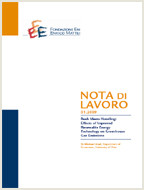Simple Myths and Basic Maths about Greening Irrigation

Data
06.02.2015
06.02.2015
Autori
Carlos M. Gómez (University of Alcalà UAH, Madrid Institute for Advanced Studies in Water Technologies IMDEA-Water); C. Dionisio Pérez-Blanco (Fondazione Eni Enrico Mattei, Centro Euro-Mediterraneo sui Cambiamenti Climatici CMCC)
Codice JEL
Q15, Q18, Q25, Q51, Q58
Q15, Q18, Q25, Q51, Q58
Parole chiave:
Jevons' Paradox, Rebound Effect, Agricultural Economics, Water Economics, Irrigation Efficiency
Jevons' Paradox, Rebound Effect, Agricultural Economics, Water Economics, Irrigation Efficiency
Publisher
Climate Change and Sustainable Development
Climate Change and Sustainable Development
Editor
Carlo Carraro
Carlo Carraro
Greening the economy is mostly about improving water governance and not only about putting the existing resource saving technical alternatives into practice. Focusing on the second and forgetting the first risks finishing with a highly efficient use of water services at the level of each individual user but with an unsustainable amount of water use for the entire economy. This might be happening already in many places with the modernization of irrigated agriculture, the world’s largest water user and the one offering the most promising water saving opportunities. In spite of high expectations, modern irrigation techniques seem not to be contributing to reduce water scarcity and increase drought resiliency. In fact, according to the little evidence available, in some areas they are resulting in higher water use. Building on basic economic principles this study aims to show the conditions under which this apparently paradoxical outcome, known as the Jevons’ Paradox, might appear. This basic model is expected to serve as guidance for assessing the actual outcomes of increasing irrigation efficiency and to discuss the changes in water governance that would be required for this to make a real contribution to sustainable water management.
***
Suggested citation: Gómez, C.M., Pérez-Blanco, 2014, “Simple Myths and Basic Maths About Greening Irrigation”, Water Resources Management 28(12), 4035-4044, doi: 10.1007/s11269-014-0725-9.
